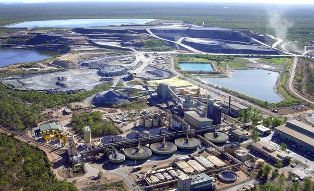Processing operations restarted today at the Ranger uranium mine, which suffered a ruptured leaching tank six months ago. Normal production levels at the mine are expected to be reached in the coming months.
 |
| Ranger (Image: ERA) |
One of several leaching tanks at Ranger mine in Australia's Northern Territory ruptured on 7 December, releasing a mixture of slurry containing mud, water, ore and acid. The plant's containment systems - including barriers and channelling - kept all the slurry mixture within the mine's processing area but processing operations at the mine have remained offline pending a report on the incident and approval for a restart plan. The clean-up of spilled slurry material was completed in late March.
Mine owner Energy Resources of Australia (ERA) announced today that it has received all the necessary regulatory approvals for a progressive restart of processing operations. These included approval from Northern Territory minister for mines and energy Willem Westra van Holthe and Australian minister for industry Ian Macfarlane.
A government-appointed taskforce has now completed its investigation into the leach tank failure and presented a report into the incident, listing ten findings and three recommendations. In a joint statement, Westra van Holthe and Macfarlane said, "ERA had developed a staged approach to restart and that their plan was appropriate and represented effective practice."
An investigation by ERA itself found that the leach tank's rubber lining had been damaged by a partially failed baffle - a plate that stirs the slurry mixture - inside the tank. Modifications made to the tank in 2009 were the likely cause of this baffle failure. The damaged lining allowed acidic slurry mixture to corrode the tank's steel wall, leading to its failure.
Resuming operations
ERA - majority owned by Rio Tinto - said processing operations would progressively be restarted and that normal production levels would be reached during the third quarter of 2014.
The government-appointed taskforce is to visit Ranger in a couple of weeks to check that the restart has occurred in accordance with the restart plan, that the remainder of the plan is on track and that its recommendations have been implemented.
ERA CEO Andrea Sutton welcomed the restart approval, noting that "This was a serious incident that damaged community confidence in our operations." She said that the company has undertaken an extensive review of plant equipment integrity, maintenance and inspection plans, as well as plant process safety. "The measures we have taken are designed to prevent anything similar happening in the future and to reassure our stakeholders and the broader community of the integrity of our operation," Sutton said.
ERA expects uranium oxide production from Ranger to be between 1100 and 1500 tonnes in 2014. The company expects the suspension of processing at Ranger to result in a loss of between AUD120 million ($110 million) and AUD140 million ($130 million) for the first half of 2014.
A similar tank failure occurred on 3 December at the Rössing mine in Namibia, in which Rio Tinto also holds a majority stake. A preliminary investigation concluded that failure was due to localised external corrosion. Processing operations at Rössing resumed in January.
Neither the Ranger or Rössing incident resulted in any injuries nor was there any environmental impact to the surrounding areas.
Researched and written
by World Nuclear News




_18570.jpg)
_16159.jpg)
_18938.jpg)
_33584.jpg)





